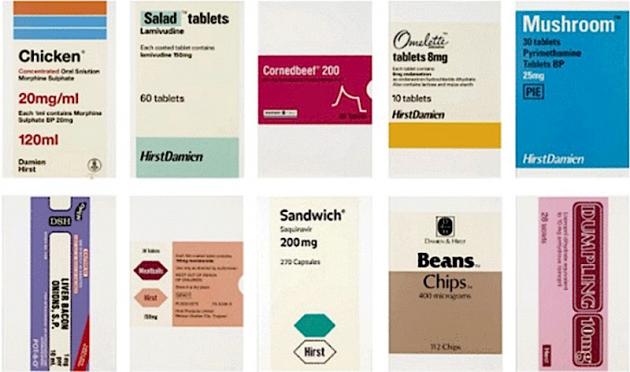A series of 13 monumental prints by the YBA artist Damien Hirst, entitled The Last Supper (1990) has been put on exhibit, at the Corcoran Gallery, part of the National Gallery in Washington. They were purchased in 2015 and have never been displayed as a complete set. Hirst is among the most prominent of the Young British Artists who revitalised the British art scene in the 1990s. In The Last Supper, he wittily explores the role of faith, viewing it in relation to art, medicine, and religion. Never before shown in Washington in its entirety, the visually arresting Last Supper series will be installed in the West Building Concourse Gallery from August 13, 2016, through January 1, 2017.
The 13 prints that make up The Last Supper refer to the number gathered at the biblical Last Supper. Hirst raises the question of whether our faith in medicine, with its promise to stave off disease and death, is now comparable to our faith in religion. He conflates minimalist pharmaceutical packaging with the form and style of art, wondering “why some people believe completely in medicine and not in art, without questioning either.” Hirst recalls watching his mother fill a prescription at a pharmacy, taking note of how at ease she was with the visual motifs used to market drugs. “My mum was looking at the same kind of stuff in the chemist’s and believing in it completely. And then, when looking at it in an art gallery, completely not believing in it.”
Each of the Last Supper prints features a pharmaceutical label that has been altered. The names of medicines have been replaced with those of common British foods (“Ethambutol Hydrochloride” becomes “Steak and Kidney,” for example) and the names or logos of the manufacturers have been replaced by those of the artist—Hirst’s own brand, so to speak. Enlarged to a heroic scale, the prints pose the question of whether pharmaceuticals—a staple of many contemporary diets—may have become not only the salvation in which we put our faith, but our daily bread.
Born in Bristol, England, in 1965, Hirst studied at Goldsmiths College in London. He first came to public attention in 1988 and went on to become one of the most prominent artists of his generation. Pharmaceuticals have played a part in Hirst’s art since his early career, beginning in 1988 with his first glass-fronted Medicine Cabinet, the shelves of which were lined with packaged drugs, culminating in 1992 with Pharmacy, an installation comprising a true-to-life pharmacy, and subsequently with the “Pharmacy Restaurant & Bar,” opened in Notting Hill in 1997. Many of his works are widely recognized, from his Physical Impossibility of Death in the Mind of Someone Living (1991), featuring a shark suspended in formaldehyde, to later works such as For the Love of God (2007)—an actual human skull studded with real diamonds. Throughout his work, Hirst takes a direct and challenging approach to ideas about existence, calling into question our awareness and convictions of the boundaries that separate desire and fear, life and death, reason and faith, love and hate. He uses the tools and iconography of science and religion, creating sculptures and paintings whose beauty and intensity offer the viewer insight into art that transcends our familiar understanding of those domains.
Hirst lives and works in Devon and London, United Kingdom. He was included in the 1992 Young British Artists exhibition at Saatchi Gallery, London, and in 1995 he won the Turner Prize. Solo exhibitions of Hirst’s work have been held at the Museo Archeologico Nazionale, Naples (2004), Astrup Fearnley Museet fur Moderne Kunst, Oslo (2005), Rijksmuseum, Amsterdam (2008), Galerie Rudolfinum, Prague (2009), The Wallace Collection, London (2009–2010), the Oceanographic Museum, Monaco (2010), the Museo di Palazzo Vecchio, Florence (2010), and Tate Modern, London (2012). Damien Hirst’s first exhibition with Gagosian Gallery was in 1996.

